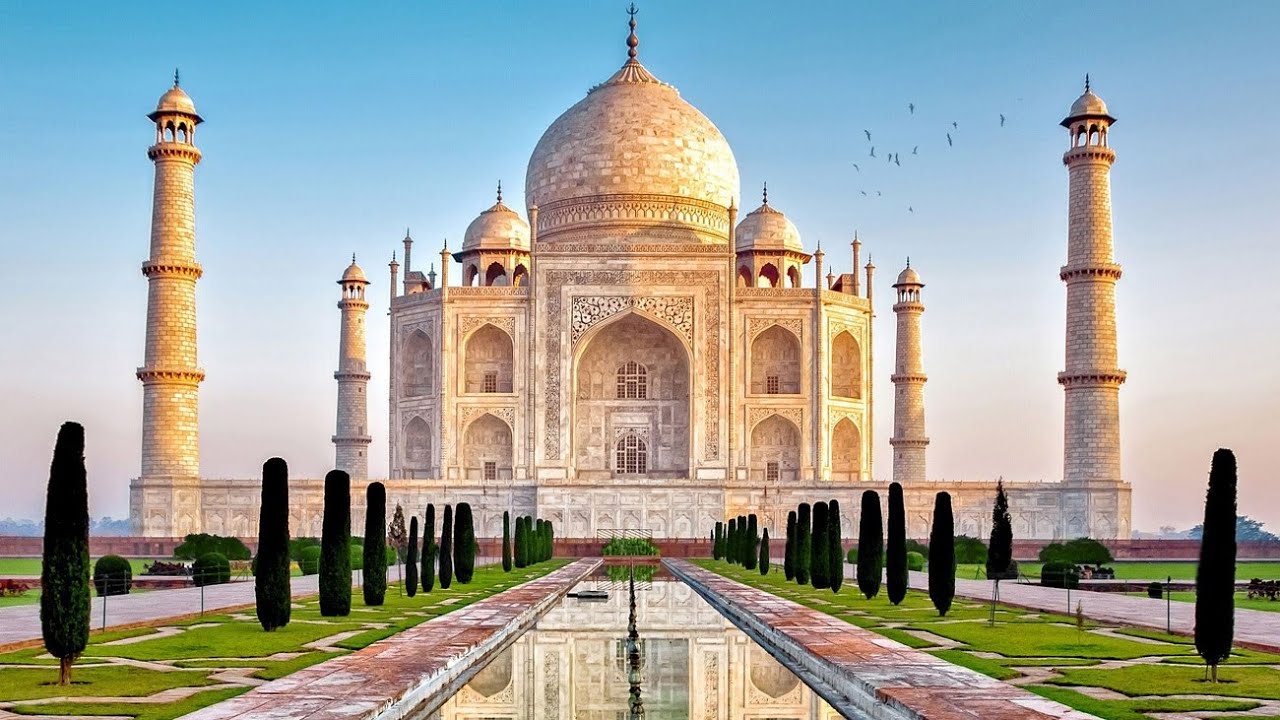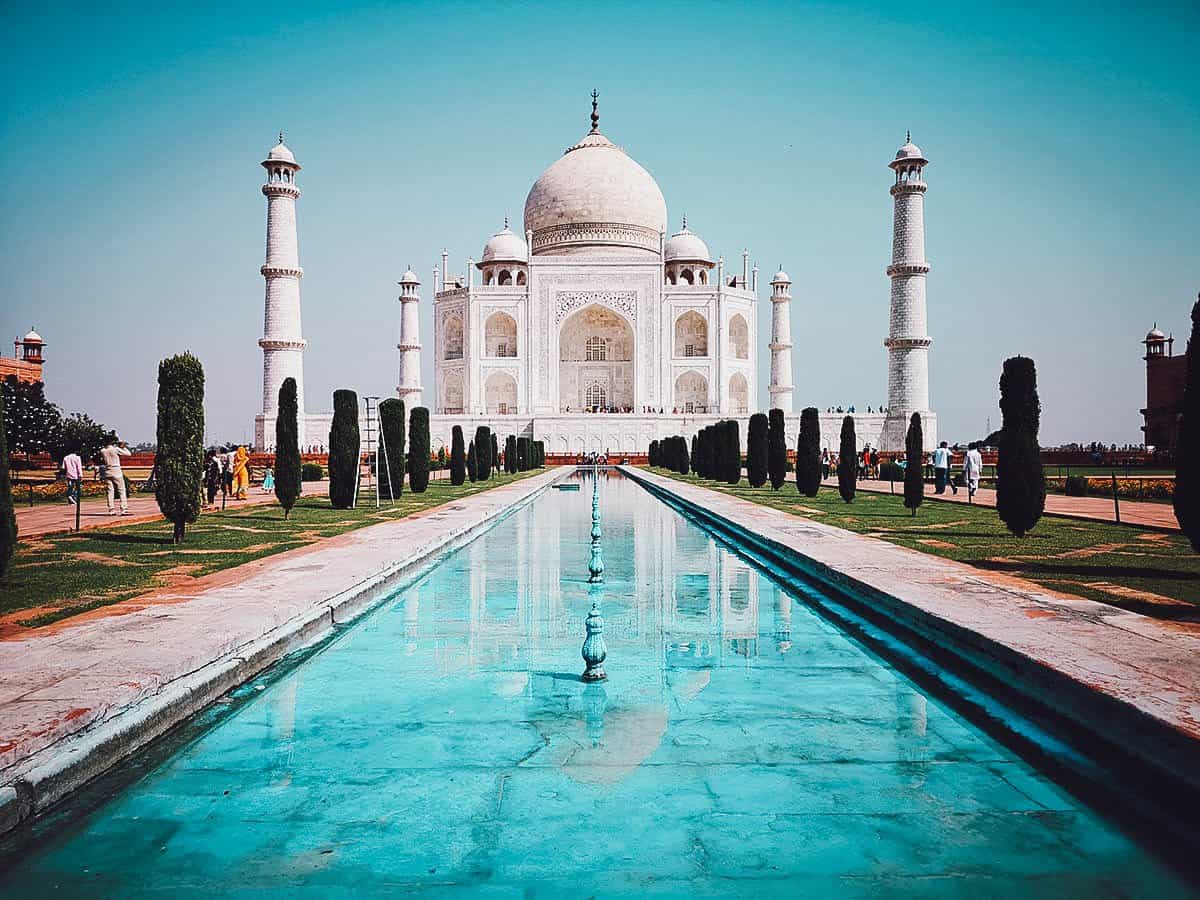Taj Mahal - Story, Hostory and Facts
The Taj Mahal is located on the right bank of the Yamuna River in a vast Mughal garden that encompasses nearly 17 hectares, in the Agra District in Uttar Pradesh. It was built by Mughal Emperor Shah Jahan in memory of his wife Mumtaz Mahal with construction starting in 1632 AD and completed in 1648 AD, with the mosque, the guest house and the main gateway on the south, the outer courtyard and its cloisters were added subsequently and completed in 1653 AD. The existence of several historical and Quaranic inscriptions in Arabic script have facilitated setting the chronology of Taj Mahal. For its construction, masons, stone-cutters, inlayers, carvers, painters, calligraphers, dome builders and other artisans were requisitioned from the whole of the empire and also from the Central Asia and Iran. Ustad-Ahmad Lahori was the main architect of the Taj Mahal.
The Taj Mahal is considered to be the greatest architectural achievement in the whole range of Indo-Islamic architecture. Its recognised architectonic beauty has a rhythmic combination of solids and voids, concave and convex and light shadow; such as arches and domes further increases the aesthetic aspect. The colour combination of lush green scape reddish pathway and blue sky over it show cases the monument in ever changing tints and moods. The relief work in marble and inlay with precious and semi precious stones make it a monument apart.
The Taj Mahal was built by the Mughal emperor Shah Jahan (reigned 1628–58) to immortalize his wife Mumtaz Mahal (“Chosen One of the Palace”). She died in childbirth in 1631, after having been the emperor’s inseparable companion since their marriage in 1612. The plans for the complex have been attributed to various architects of the period, though the chief architect was probably Ustad Ahmad Lahawrī, an Indian of Persian descent. The five principal elements of the complex—main gateway, garden, mosque, jawāb (literally “answer”; a building mirroring the mosque), and mausoleum (including its four minarets)—were conceived and designed as a unified entity according to the tenets of Mughal building practice, which allowed no subsequent addition or alteration. Building commenced about 1632. More than 20,000 workers were employed from India, Persia, the Ottoman empire, and Europe to complete the mausoleum itself by about 1638–39; the adjunct buildings were finished by 1643, and decoration work continued until at least 1647. In total, construction of the 42-acre (17-hectare) complex spanned 22 years.
A tradition relates that Shah Jahān originally intended to build another mausoleum across the river to house his own remains. That structure was to have been constructed of black marble, and it was to have been connected by a bridge to the Taj Mahal. He was deposed in 1658 by his son Aurangzeb, however, and was imprisoned for the rest of his life in Agra Fort.
The architects and craftsmen of the Taj Mahal were masters of proportions and tricks of the eye. When you first approach the main gate that frames the Taj, for example, the monument appears incredibly close and large. But as you get closer, it shrinks in size—exactly the opposite of what you’d expect. And although the minarets surrounding the tomb look perfectly upright, the towers actually lean outward, which serves both form and function: in addition to providing aesthetic balance, the pillars would crumble away from the main crypt in a disaster like an earthquake.
According to a popular legend, Shah Jahan wanted desperately for the mausoleum to be an exquisite masterpiece without an equal. To ensure no one could recreate the Taj Mahal’s beauty, Shah Jahan supposedly severed the hands and gouged the eyes of the artisans and craftsmen. Despite the prevalence of this gruesome tale, historians have found no evidence to support the story—though it does heighten the drama of the romantic tragedy.
Age and pollution has taken a toll on the Taj Mahal’s gleaming white marble façade, which has turned brownish-yellow under the sooty conditions. Occaionally, the monument is given a spa day. Specifically, a mudpack facial called multiani mitti. This traditional recipe used by Indian women to restore radiance is applied, and then washed off with brushes, after which the Taj’s blemishes vanish, and its glow returns.
One of the allures of the Taj Mahal is its constantly changing hue. From dawn to dusk, the sun transforms the mausoleum. It may seem pearly gray and pale pink at sunrise, dazzling white at high noon, and an orange-bronze when the sun sets. In the evenings, the Taj can appear translucent blue. Special tickets are even sold for full moon and eclipse viewings.
Accounts have shown that, as a leader, Shah Jahan was more ruthless than romantic. For all its associations to devotion and ardor, the Taj was also a source of propaganda. The complex’s ordered symmetry symbolizes absolute power—the perfection of Mughal leadership. And its grand scale and extravagance (crystal, lapis lazuli, makrana marble, turquoise) only brought glory to Shah Jahan’s reign.
The Taj Mahal is the pinnacle of Mughal architecture, constructed with impeccable symmetry according to the doctrines of the period’s style. Minarets flank the domed tomb, and a central pool reflects the main building. The gardens—an earthly representation of paradise—are divided into quadrants, and twin red sandstone buildings (an east-facing mosque and a west-facing guesthouse) give the mausoleum complex a balanced harmony. There is, however, one exception. Shah Jahan’s cenotaph is peculiarly positioned west of the central axis, throwing off the equilibrium. The odd placement has led many to believe he never meant to be buried there at all.
Inside the Taj Mahal, the cenotaphs honoring Mumtaz Mahal and Shah Jahan are enclosed in an eight-sided chamber ornamented with pietra dura (an inlay with semi-precious stones) and a marble lattice screen. But the gorgeous monuments are just for show: The real sarcophagi are in a quiet room below, at garden level.
Remember the haphazard placement of Shah Jahan’s cenotaph? Local lore says that Shah Jahan wanted to construct a shadow image across the Yamuna River—an identical, but opposite Taj Mahal hewn from black marble—where he would be entombed. It was said that construction came to a halt after Shah Jahan was deposed by his son (ironically, a child of Mumtaz Mahal) and imprisoned at the nearby Agra Fort. Some historians have dismissed this story as folklore, too.
Facts
The Taj Mahal was built by a whopping 22,000 laborers, painters, stonecutters, embroidery artists.
The changing moods of the Emperors wife are well captured by the changing hues of the Mausoleum at different times of the day. It takes a pinkish hue in the morning, milky white in the evening and golden at night when illuminated by moonlight.
The most recognizable feature is the white dome at the peak of the mausoleum. Often called the 'onion dome', it rises to about 35 meters (115 feet) and is surrounded by four other domes.
As always, rumor mills are on the overdrive about this mausoleum. It is rumored that the Emperor ordered that all the workers who worked on the mausoleum get their hands chopped of so that no one could make anything like it ever again.
The materials that were used to build Taj Mahal were transported to the construction site by a whopping 1,000 elephants.
Many of the precious stones on the mausoleum were ripped off from the walls of the mausoleum by the British army during the Indian rebellion of 1857.
If it was to be built today, Taj Mahal would cost the Emperor about US$100 to make it as beautiful as it is.
Taj Mahal is a famous Indian landmark and tourist magnet, attracting more than a million tourists every year.
It intricate work of art and architectural genius took 17 years to complete.
Legend has it that Emperor Shah Jahan intended to build another Taj Mahal in black marble across the river but a war with his sons interrupted these plans.
Taj Mahal is indeed a beautiful place. When you visit, make sure you take a picture of yourself and your spouse with the mausoleum as the background...who knows, the love that the emperor had for his wife to dedicate this kind of resources for her remembrance after death might rub off on you.
from :-- https://www.uniglobecarefreetravel.com
https://www.smithsonianmag.com
https://whc.unesco.org



No comments